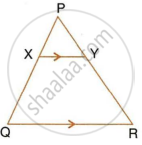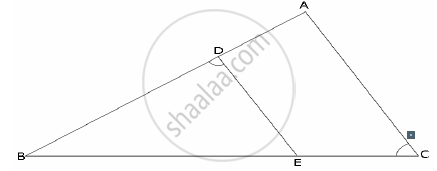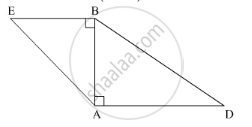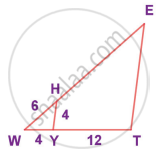Advertisements
Advertisements
Question
The given figure shows a triangle PQR in which XY is parallel to QR. If PX : XQ = 1 : 3 and QR = 9 cm, find the length of XY.

Further, if the area of ΔPXY = x cm2; find, in terms of x the area of :
- triangle PQR.
- trapezium XQRY.
Solution
In ΔPXY and ΔPQR, XY is parallel to QR, so corresponding angles are equal.
∠PXY = ∠PQR
∠PYX = ∠PRQ
Hence, ΔPXY ∼ ΔPQR ...(By AA similarity criterion)
`(PX)/(PQ) = (XY)/(QR)`
`=> 1/4 = (XY)/(QR)` ...(PX : XQ = 1 : 3 `=>` PX : PQ = 1 : 4)
`=> 1/4 = (XY)/(9)`
`=>` XY = 2.25 cm
i. We know that the ratio of areas of two similar triangles is equal to the ratio of the squares of their corresponding sides.
`(Ar(ΔPXY))/(Ar(ΔPQR)) = ((PX)/(PQ))^2 `
`x/(Ar(ΔPQR)) = (1/4)^2 = 1/16`
Ar (ΔPQR) = 16x cm2
ii. Ar (trapezium XQRY) = Ar (ΔPQR) – Ar (ΔPXY)
= (16x – x) cm2
= 15x cm2
APPEARS IN
RELATED QUESTIONS
In the given figure ABC is a triangle with ∠EDB = ∠ACB. Prove that Δ ABC ~ Δ EBD. If BE = 6 cm, EC = 4 cm, BD = 5 cm. And area of Δ BED = 9 cm2. Calculate the
(1) length of AB
(2) area of Δ ABC

In the following figure, seg BE ⊥ seg AB and seg BA ⊥ seg AD. If BE = 6 and \[\text{AD} = 9 \text{ find} \frac{A\left( \Delta ABE \right)}{A\left( \Delta BAD \right)} \cdot\]

The scale of a map is 1 : 200000. A plot of land of area 20km2 is to be represented on the map. Find:
The area in km2 that can be represented by 1 cm2
A line PQ is drawn parallel to the side BC of ΔABC which cuts side AB at P and side AC at Q. If AB = 9.0 cm, CA = 6.0 cm and AQ = 4.2 cm, find the length of AP.
In a quadrilateral PQRS, the diagonals PR and QS intersect each other at the point T. If PT:TR = QT :TS = 1:2, show that ΔPTQ - DRTS
The areas of two similar triangles are 169cm2 and 121cm2 respectively. If one side of the larger triangle is 26cm, find the length of the corresponding side of the smaller triangle.
In ΔABC, DE is drawn parallel to BC cutting AB in the ratio 2 : 3. Calculate:
(i) `("area"(Δ"ADE"))/("area"(Δ"ABC")`
(i) `("area"("trapeziumEDBC"))/("area"(Δ"ABC"))`
D is the mid point of side BC and AE ⊥ BC. If BC = a, AC = b, AB = c, ED = x, AD = p and AE = h, prove that c2 = `"p"^2 - "a"x + "a"^2/4`
In the given figure YH || TE. Prove that ΔWHY ~ ΔWET and also find HE and TE
If in triangles PQR and XYZ, `"PQ"/"XY" = "QR"/"ZX"` then they will be similar if
